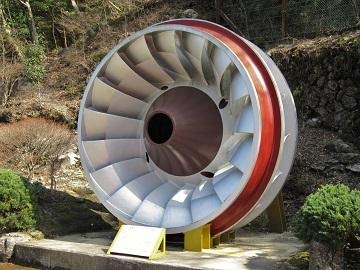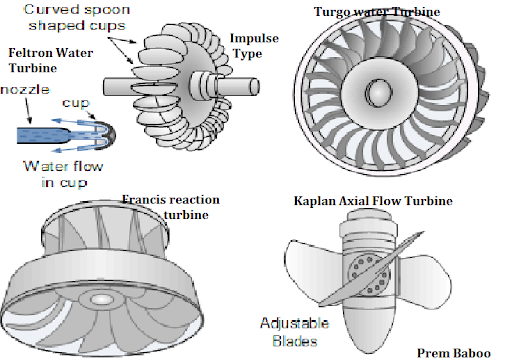What is a Water Turbine How do Water Turbines Work?
For years, water turbines have been used for generating electricity. This form of power generation is still in existence to date. People, companies, and governments are heavily investing in water turbines.
Are you planning to buy and use a water turbine for electric generation? Read on as we feed you with valuable information.

What is a water turbine?
A water turbine is a water wheel or simply a rotary system that uses water power to generate electrical energy. The water flows through the turbine as it moves from one location to another.
This motion causes the shaft of the water turbine to rotate which generates mechanical energy into an electrical generator for useful work such as electricity generation.
This simple machine turns kinetic energy into potential and then back again. It has been used for centuries and was built by many people all over the world throughout history.
Water turbines are found on different hydro sites such as rivers and dams where water flows along pipes or channels using a force known as a hydraulic head.
These are commonly operated by regulating water’s flow rate so that it increases speed while moving down towards the bottom of dam stream, or reservoir.
The water exerts great pressure on water turbine blades and shaft when it moves against the flow of water. The more water in the water pipeline, the greater will be its hydro-potential energy!
How do water turbines work?
The water flowing in water turbines is released from the reservoir through pipes and then it pushes water turbine axles to leave behind energy. This energy is converted into mechanical energy which turns water turbine blades and shafts, thus producing electricity.
Subsequently, water turbines are highly efficient when compared with other forms of water power technology. For instance, water wheels have low-efficiency ratings of just 19% while water turbines have higher efficiency ratings because they transform the energy that flows inside them into mechanical energy.
The latter has the extra advantage of generating electricity through a generator positioned alongside or within the turbine!
Water Turbine Components:
Water Turbines consist of five major components namely, runner (impeller), a drive mechanism (geared system), casing/housing, tailwater (tailrace), and water blockage device.
- Runner (Impeller) – It is the main water component of a water turbine and consists of curved blades which are directed in such a way as to directly catch water flow from a river with low speed and water current for power generation in water turbines.
- Drive Mechanism – This is an assembly or group of gears that transforms rotary motion into linear motion. These mechanisms use Water Turbine drive shafts to transfer water stream energy to the generator machine that produces electrical energy.
- Casing / Housing – The body serves as housing for all water turbine components including water inlet structure where water flowing from the dam enters.
- Water Blockage Device – It is an obstruction placed across the stream of water from a dam to prevent it from spilling into turbine tailwaters and causing damage in case of a sudden rise in reservoir water level during peak electricity generation periods
- Tail Race – This is a channel or pipe where the water flows through once it has passed through turbine blades, other components and leaves a spinning shaft that produces electricity. The turbine’s tailrace conducts water back to its source near the dam or to a tidal basin where fish can be released if they are endangered by rising water levels. Before leaving, however, higher speed tailrace flow may turn one-stage turbines as well as some two-stage turbines.
- Water Turbine Generator – water turbine generator is a device that converts water power energy into electrical energy by means of electromagnetic induction water pipes or coils (the rotor).
The mechanical force used to spin these coils comes from the prime mover, which in most cases is an electric motor. Some turbines are geared to rotate at high speed; others transmit motion through gears to drive other machines such as pumps and compressors.
Water turbine design
Designing water turbines means creating a useable water generator that will be able to generate electricity with the least amount of water inlet pressure and resistance possible.
The design also ensures that enough water power capacity to produce adequate amounts of electricity. This can be done by making water turbines blades more streamlined or increasing their number.
Each design must also have an appropriate size that will depend on the speed and amount of water used by each turbine.
All in all, the design will determine the overall performance and efficiency of the water turbine.
Classifications of water turbines
Water turbines are divided into two main classes. These are impulse turbines and reaction turbines. What are the differences between these two?
Impulse water turbines
These water turbines use water pressure to rotate the water turbine blades. The water is directed onto the water turbine runner so that it becomes a high-speed jet of water flow.
The impulse turbine consists of an enormous wheel or ring that has paddles mounted on it, which as we know, are called runners.
Reaction turbines:
These water turbine types do not have any type of wheels but rather a nozzle to produce power from flowing waters because they rely on the reaction force produced by the incoming gases that drive them forward.
The reaction turbines depend on exhaust gas forces and momentum generated by their movement through nozzles at high speeds to rotate at high speeds within their own axis.
How efficient is a water turbine generator?
Water turbines are the most environment-friendly ways of producing power as they use all available natural resources instead of damaging our planet by releasing toxic gases into the atmosphere.
Yet, they still do not have a 100% efficiency rate. Most modern-day water turbine generator kit houses an overall efficiency rating of at least 90%. Buy from the best water turbine manufacturers for more efficient systems.

Conclusion water
Water turbine generators are an extremely useful and important natural resource to truly harness the great power of our planet’s most abundant resource – water.
They create clean sources of energy, but they’re still exist ways how we can maximize their potential as well as reduce overall cost and demand for electricity today and in the years to come.
Would you like to learn more about water turbines? Don’t hesitate to contact reliable water turbine manufacturers for more information.

 By Suneco Hydro
By Suneco Hydro


